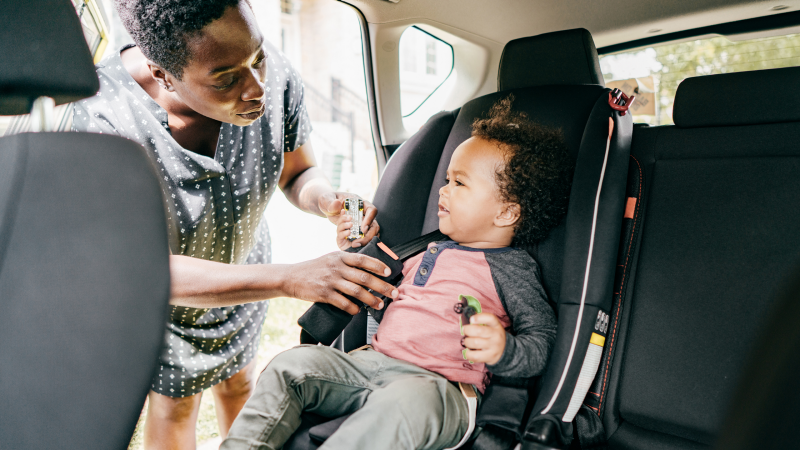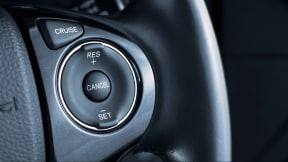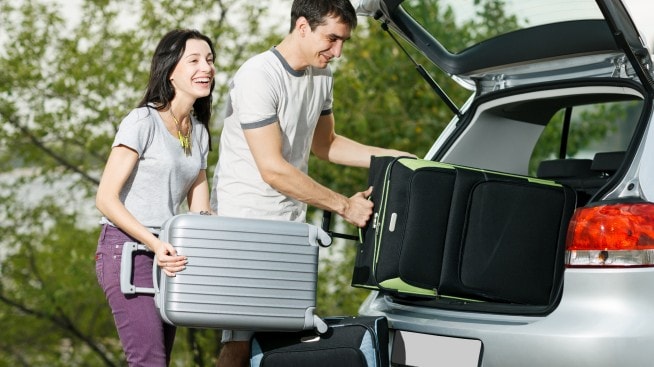What to know about child booster seats

Childhood is all about transitions, and car seat safety is no different. When your kids have outgrown their forward-facing car seats but remain a little too small to safely use a seatbelt on its own, it’s probably time for a child booster seat. A booster seat raises your child several inches so that the seatbelt can be positioned correctly across their body, helping to minimize the risk of physical injury to your child in the event of a collision.
Why child booster seats are important
Child booster seats are important because, correctly fitted, seatbelts save lives. However, since seatbelts are designed with adult-sized bodies in mind, a smaller child runs the risk of physical injury if the belt is positioned incorrectly in the event of a crash. By “boosting” the child up, the seatbelt can more comfortably fall across critical points of the shoulder, chest and lap.
According to the Centers for Disease Control and Prevention (CDC), appropriately fitted seatbelts reduce the risk of serious injury or death for older children in crashes by about half. As such, child booster seats are an important safety feature to consider for anyone responsible for driving children.
Age ranges for child booster seat use
Knowing when to use a child booster seat for your younger passengers isn’t an exact science. There’s no set day when a child should move from a forward-facing car seat into a booster. However, there are some safety guidelines and requirements to keep in mind.
When can a child use a booster seat?
Typically, booster seats are intended for kids anywhere from 7 to 12 years old who have outgrown their front-facing child car seats. Every child is different, though. A youngster who is noticeably bigger or smaller than others in their age group may need a different-sized seat from that of their peers.
For this reason, when deciding whether your child can use a booster seat, it’s generally best to consult the seat manufacturer’s recommended weight and height requirements. Knowing your state’s minimum requirements for child seat use is typically a good idea, too.
When can my child stop using a booster seat?
Kids usually grow out of a child booster seat when they are between 9 and 12 years old. This is usually around when they can use a seat belt safely without being raised. As always, it helps to know the height and weight limits of the seat your child is using, along with any state laws.
Types of child booster seats
A child’s booster seat for your car can come in several types. From backless boosters to all-in-one systems, there’s a seat for most every scenario.
Backless boosters
True to its name, a backless booster has no back, though it does have armrests. These seats are typically easier to move around than high-backed booster seats. They may also suit older or larger children who are close to ready for traveling with the seatbelt only.
High-backed boosters
This high-backed seat is designed to cushion your child's head in the event of a collision. A high-backed booster often makes sense if your vehicle’s rear seats lack headrests or high seat backs. A high-backed booster may also offer extra support in case of a side impact.
Combination seats
A combination seat, sometimes referred to as a convertible booster seat, begins life as a forward-facing seat. Once your child is old enough, it can be converted into a child booster seat by following the manufacturer’s directions.
All-in-one seats
An all-in-one seat pulls triple duty from infancy. The all-in-one begins as a rear-facing seat, converts to a forward-facing unit, then emerges in its final iteration as a child booster seat.
Installing a child booster seat
When it comes to installing a booster seat, it’s best to follow the manufacturer’s directions carefully. While installation may differ from seat to seat, booster seats are generally designed to use your child’s weight to help secure the seat in place, with the seat belt going over the child.
Some boosters may additionally offer the LATCH (Lower Anchors and Tethers for Children) system to help further secure the seat. With the LATCH system, lower anchors clip on to small horizontal bars, which can be found between the bottom cushion and the back of the vehicle seat.
In addition to consulting the manufacturer’s guide for installation, you may want to read up on any child booster seat requirements for the state or states that you drive in. Some states may even offer services where you can bring in your car to a designated installation facility where they’ll install the seat for you. This might be especially helpful for new parents or guardians who’d like a little extra help.
Additional booster seat considerations
There’s more to child car safety than simply the installation of the booster seat. For instance, there’s how to select the right child booster seat in the first place and how to properly fit the seat belt across your child.
Selecting a child booster seat
Safety comes first when selecting a child’s booster seat, and a little research can help you better understand your options. There’s a vast amount of information about booster seats to explore online. You’ll find product explainer videos and the manufacturer’s safety data sheets as well as comparison tables and other educational content. Customer reviews can give good insights into different booster seats too.
If you’re considering a used booster seat, it’s best to check it carefully for any signs of damage or aging, such as cracks or broken plastic. Can you be sure the seat hasn’t been involved in any collisions? If you have any doubts or concerns, it’s typically safer to err on the side of caution. Child car seats may also have expiration dates, which could be good to check up on.
Fitting the seat belt
The seatbelt should fit snugly and without twists across your child, falling across the shoulder, chest and lap. It should never fall across the face, across the neck, under the arm or behind the back. Some child booster seats come with guides or plastic clips to help position the belt. Before setting off on your journey, it’s best to check that your child is properly buckled in.
Safety recalls
If your booster seat is subject to a product safety recall, it’s important to follow any directions the manufacturer gives for remedying the problem. Completing and mailing in the registration card that comes with the seat at the time of purchase can help you receive safety notifications promptly.
In summary
Child booster seats help kids more safely transition from a forward-facing car seat to using the seatbelt alone. Understanding how to use a booster seat properly, in accordance with the manufacturer’s directions and any state-level requirements, is the first step in the next phase of your child’s growth journey.



